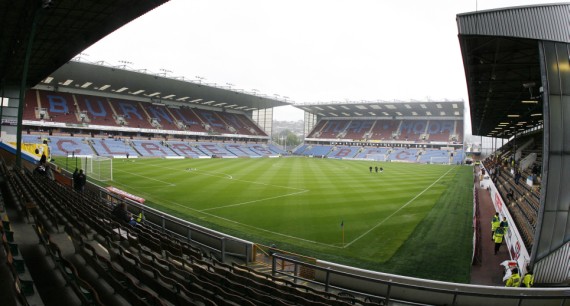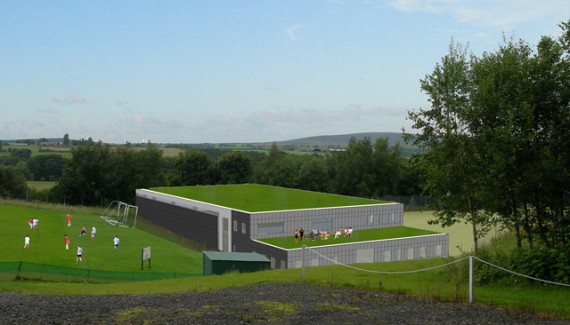Turf Moor has, for over a decade now, looked as if has been stuck in a time warp between two eras: half cantilevered and imposing, all plastic and glass; half stanchion-supported and nostalgic with wooden seats and a low-slung look.
|
It hasn't ever been ideal: for one thing, the difference in height between the Bob Lord and the new Longside has always made Turf Moor less intimidating, with the noise of the more vocal faithful in the upper tier of the new stand dissipating up and away, far over the top of the rest of the ground. And the contrast between the two halves of the ground has tended to exacerbate the impression of the two 70's numbers as tin-pot and increasingly aged.
Or, to look at it another way, those two newer stands never looked entirely in keeping with the character of what they replaced in the mid 90's - the old Turf Moor, two sides of comfortable seating and two of banked terracing, enclosing the pitch and watching threateningly over the top of it. Out of proportion to not just the rest of the ground but even to the surrounding town, they have always been difficult to fall in love with, always an unnecessarily large statement in the context of a club knocking around the middle two divisions of the league structure.
Getting your ground right is so very important. It creates the impression of Burnley Football Club which can attract or deter potential players, staff, supporters and commercial investors. And because of the investment required, it is something which you must get right or else be saddled with the legacy for a generation. Redeeming mistakes is not an easy business.
Mistakes were made and opportunities were missed last time round: not mistakes unique to Burnley, for they were replicated in new grounds throughout the country, but ones which I have been desperately hoping would not be replicated in this latest one-off opportunity to redefine the image of this club. Hindsight is a wonderful thing, and it tells us that the best new stands are not built towards the skies in double or even multiple tiers, but in a single tier rolling down to pitch side in a style reminiscent of those old terraces, sufficiently compact as to gather supporters together.
We built two quarters of a near 30,000 capacity, football-only stadium which was never likely to be regularly full: the result is wide open spaces even now. Imagine how it would look with that enlarged capacity, people sitting in dispersed, disparate groups. It left future developers with an unenviable dilemma: how to maintain a sensible capacity without ending up with a ground containing two halves of contradictory scale.
The most promising aspect of the stadium plans is that, in the case of the Cricket Field Stand in particular, the rough sketches appear to indicate that this might have been achieved. More importantly, it seems we are going to grasp the opportunity to develop Turf Moor so it is no longer just a football ground - but rather a genuinely multi-functional venue which retains football at its heart and soul.
We get a hotel and enhanced corporate facilities and an enterprise centre - all of which will create valuable revenue for the club, whilst conveniently strengthening the stature of the club in the town. And the plans look creative too; they appear to have borne in mind the value of creating a unique identity for the home of the Clarets, in stark contrast to the multitude of stadiums which now bear the handprint of one of the few companies who have each been responsible for a string of generic football developments.
We await an insight into how exactly that will be done of course, since an explanation of how the internal space will be filled - or a projection of the stand from the pitch - has not been forthcoming. One might be curious to know how the cinema complex will be incorporated into the ground, or wonder about the extent of the potential for further conference facilities at the top end of the M65. But then, it is hardly like we have an amateur in charge, what with him being one of the leading property developers in the north of England and all.
And leaving aside the stadium, this would be a red letter day if the only announcement had concerned Gawthorpe. The argument that youth development should be at the heart of our strategy has long since been won. But these things take investment, and a lack of capital, not to mention planning constraints, have prevented that until now, and so we have been left fighting an uphill battle for decent kids, and then facing an equal challenge to keep them. But now we learn that, at last, the funds are there to gain academy status, to allow us to compete with the likes of the Premiership clubs and Crewe Alexandra that the tide is changing, and the existing coaches and scouts will be supplemented, and given the facilities that allow us to compete against the bigger clubs.
|
That is hugely significant, it really is. We've been told for a long time that club is getting its house in order in this respect - but whilst the coaching is undoubtedly very good and facilities have been slowly improving, the reality is that there have been few tangible end-products who have made it to the first team. The truth is that, these days, it is always unlikely that you will produce anything more than a steady trickle of players who are good enough, but even that is better than the isolated drips we have managed in the past 25 years.
But beyond the practicalities and the bricks and mortar, there is an important bigger picture. The news demonstrates loud and clear attitude of those guiding our club forwards. It demonstrates ambition of course, in bucket loads - but these are not the visions of dreamers with impossible ideals. We are being driven by fans who have managed to plan for their football club whilst using all their most remaining grounded in the pragmatic reality of running that club as a business.
I think that is why I am genuinely excited. At the end of the day, it is the team and whether it can compete which is the ultimate measure of success and failure - not whether you have the finest stadium or the best training ground since time began. The great thing about these plans is that the eye is focussed firmly on that ball. It is geared towards generating the funds to help us compete better on the field in the longer term, after any millions Flood might make available for team building have long since dried up.
These are, of course, just paper plans at the moment, and there is always the risk that grand projections prove altogether less vibrant. But, at face value, this is Brendan Flood and Barry Kilby being true to their words and creating a Burnley Football Club in which it is, at the very least closer to becoming a self-sufficient business capable of sustaining Championship football in its own right. We have not just seen plans for a new stand or two today, or a couple of new training pitches. Rather, we have seen plans for a whole new infrastructure.


